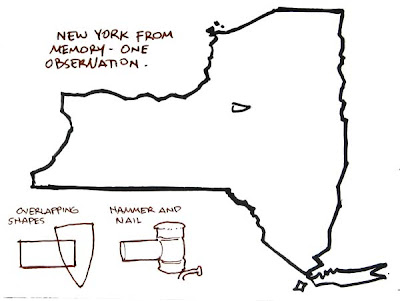Are you ready for a visual memory game? Please stop what you’re doing and grab a pencil and paper, and try not to scroll down to the pictures yet.
Without looking at a map or searching on the computer, draw from memory the shape of your state or province. People from Wyoming or Colorado can draw Texas.
When you’ve finished that, draw the outside shape of the continental United States—or of your country, wherever you live.
It doesn’t have to be too detailed, and don’t worry if you’re not sure, just give it a try.
On the left, below, is what Jeanette came up with for New York state. Mine is in the middle. I’m a little embarrassed of mine! I’ve driven all over the state, and I mistakenly thought the western end was squared off. But both of us got Long Island at least.

On the right is my memory drawing of the continental US. It’s got quite a few mistakes, especially around the Great Lakes, but it’s not too bad. The only reason it’s OK is that I’ve played this game before.
Now the next step is to find a map and look at it as long as you want: two minutes, five minutes, or longer. But only look one time! When you’re done looking, go somewhere and draw the shape again.

My second pass at New York State is better, but still has a lot of things wrong. I tried to conceptualize the shape as I observed it by thinking of two overlapping shapes, or of the metaphor of a hammer hitting a bent nail.
Here’s what I learned:
1. I tended to enlarge areas that I’m familiar with.
2. It helps to have a metaphorical symbol of something you need to remember.
3. When observing to remember, as Gannam said yesterday, the eye is much more searching, and takes a greater interest in the relationship of large and small shapes.
Thanks for all the great comments yesterday, everybody. Tomorrow's topic: Remembering a face
Memory Series
Part 1:
Art and Memory
Part 2:
Memory Game
Part 3:
Remembering a Face
























































